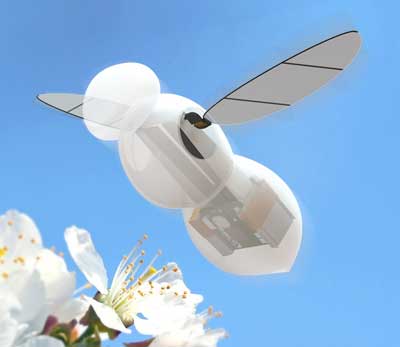| Mar 01, 2018 |
Robotic spiders and bees: The rise of bioinspired microrobots
|
|
(Nanowerk News) Jumping robot spiders and swarms of robotic bees sounds like the stuff of science fiction, but researchers at The University of Manchester are already working on such projects and aiming to lead the world in micro robotics.
|
 |
| Imagine if the current trend of a declining bee population continues, swarms of robot bees pollinating crops and flowers could become a reality. (Image: University of Manchester)
|
|
But what will these kinds of robots be used for and is it something we should be worried? Dr Mostafa Nabawy is the Microsystems Research Theme Leader at The University of Manchester's School of Mechanical, Aerospace and Civil Engineering. He is presenting some of his research, "Spiders Attack: The rise of bioinspired microrobots" at Manchester's Industry 4.0 Summit on Thursday 1 March.
|
|
Here Dr Nabawy explains why micro robots really aren't anything to worry about and, instead, could be the revolution in robotics that spearheads the next generation in manufacturing technology:
|
|
'For our robotic spiders research we are looking at a specific species of jumping spider called Phidippus regius. We have trained it to jump different distances and heights, recording the spider's every movement in extreme detail through high resolution cameras which can be slowed down.
|
|
'We are now using this bio-mechanical data to model robots that can perform with the same abilities. With this extensive dataset we have already started developing prototype robots that can mimic these biomechanical movements and jump several centimetres.'
|
|
Why jumping spiders you ask? Unlike humans, our spiders can jump up to six-times longer than their own body length from a standing start. In comparison, the maximum a human can jump is just one and half times. Dr Nabawy says if we can perfect the way spiders jump in robots they can be used for a variety of different purposes in complex engineering and manufacturing and can be deployed in unknown environments to execute different missions.
|
|
Dr Nabawy's research and background is in aerodynamics, aircraft design, and the modelling of engineering systems. But he is now combining this expertise with bio-inspired flying and jumping technologies, including flying robot bees.
|
|
He added: 'The ultimate aim is to create a robot bee that can fly independently and we're quite a long way into that project. But there are also many different opportunities for brilliant science and engineering outcomes along the way so it is a very exciting process.
|
|
'We're aiming to create the world's first robot bee that can fly unaided and unaccompanied. These technologies can also be used for many different applications, including improving the current aerodynamic performances of aircraft.
|
|
'Or, imagine if the current trend of a declining bee population continues, swarms of robot bees pollinating crops and flowers could become a reality. Whilst this may sound like something out of a transformers film this is our ultimate aim. But don't worry we are someway off swarms of flying mechanical bees and armies of mechanical spider robots.'
|

